Home Blog Business How to Create a Winning Sales Plan Presentation

How to Create a Winning Sales Plan Presentation

As sales professionals, you are used to writing sales plans, but presenting them to stakeholders is a different story. People in your organization, including executives and decision-makers, often possess high-level industry knowledge and business acumen. They are also incredibly impatient and don’t have time to sit for long presentations. Therefore, your sales plan presentation should go beyond mere information-sharing; it should be about aligning your sales plan with their existing understanding concisely and time-efficiently.
In this article, we will guide you through the process of creating a presentation material based on your sales plan. Expect useful presentation templates along the way!
Table of Contents
Key Elements of an Effective Sales Plan Presentation
Executive summary, goals and objectives, market analysis, sales strategies and tactics, financial projections, contingency plan and risk management.
- Tips for Sales Presentations
Preparing your sales plan presentation parallels your steps when writing the document. After all, your goal didn’t change; that is, to spell out the objectives, strategies, and implementation measures guiding your sales efforts.
Your sales plan presentation should cover the following elements.
Let’s discuss each component in detail.
An executive summary is the preface to your larger sales plan document, so it should also precede the body of your sales plan presentation. This slide provides a concise overview of the entire sales plan, including your objectives and strategies, setting the stage for what’s to come.
Normally, executive summaries are written in paragraph form proportionate to the report’s length. But it is different when it comes to PowerPoint presentations. Executive summary slides should be visually dynamic to draw the audience’s attention to the most critical information of the report.
Here’s an example of a sales plan presentation’s executive summary slide . Note that the following slides outline a hypothetical sales plan for FreshBite Delivery, a fictitious company. The data and market trends presented in this example are for illustrative purposes only and do not reflect actual market conditions.
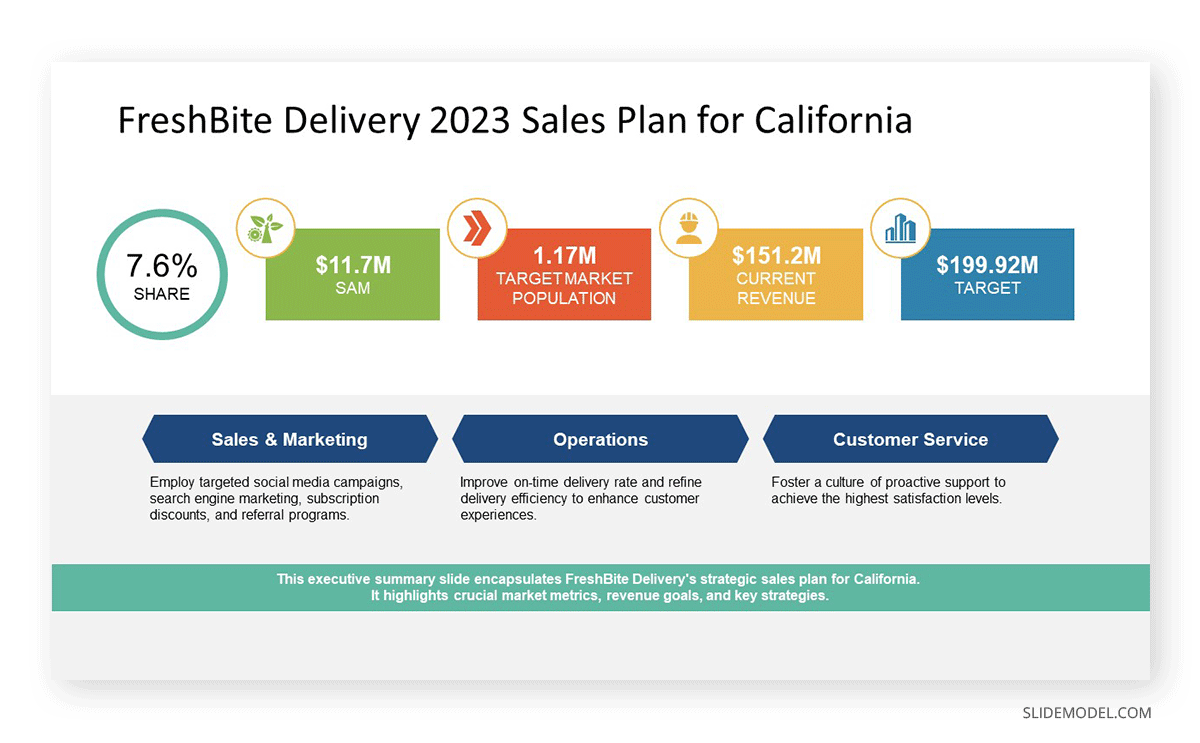
Following the executive summary is a slide/s that outlines the goals and objectives you want to achieve with your sales efforts. Depending on the size of your organization, this part might cover the specific goals of each department involved in the sale. Imagine being in a larger company; different groups might work parts of the sales process. So, you’d discuss the goals for each of those groups.
You may talk about when you expect certain things to happen as well. Like, when do you plan to reach certain milestones? For the employees, this helps create a clear line of sight between the goals and their day-to-day work. For decision-makers, this shows where the sales plan is taking the company.
Let’s continue our FreshBite Delivery sales plan and see what a Goals and Objectives slide may look like.

Presenting the findings of your market analysis activity holds significant importance in proving the validity of your chosen sales goals and strategies. Your market analysis presentation builds confidence among decision-makers that your approach is grounded in a solid understanding of the market’s realities. Through this section, you can also address a crucial concern they often have: whether there’s a genuine demand or space for your products or services.
There are several market analysis templates you can use, but the best ones should allow you to do the following:
- Assess available market factors (e.g., volume and value)
- Identify and quantify target customer
- Identify competitors
For example, FreshBite Delivery’s market analysis presentation could include a slide dissecting the market segments they can turn into customers.
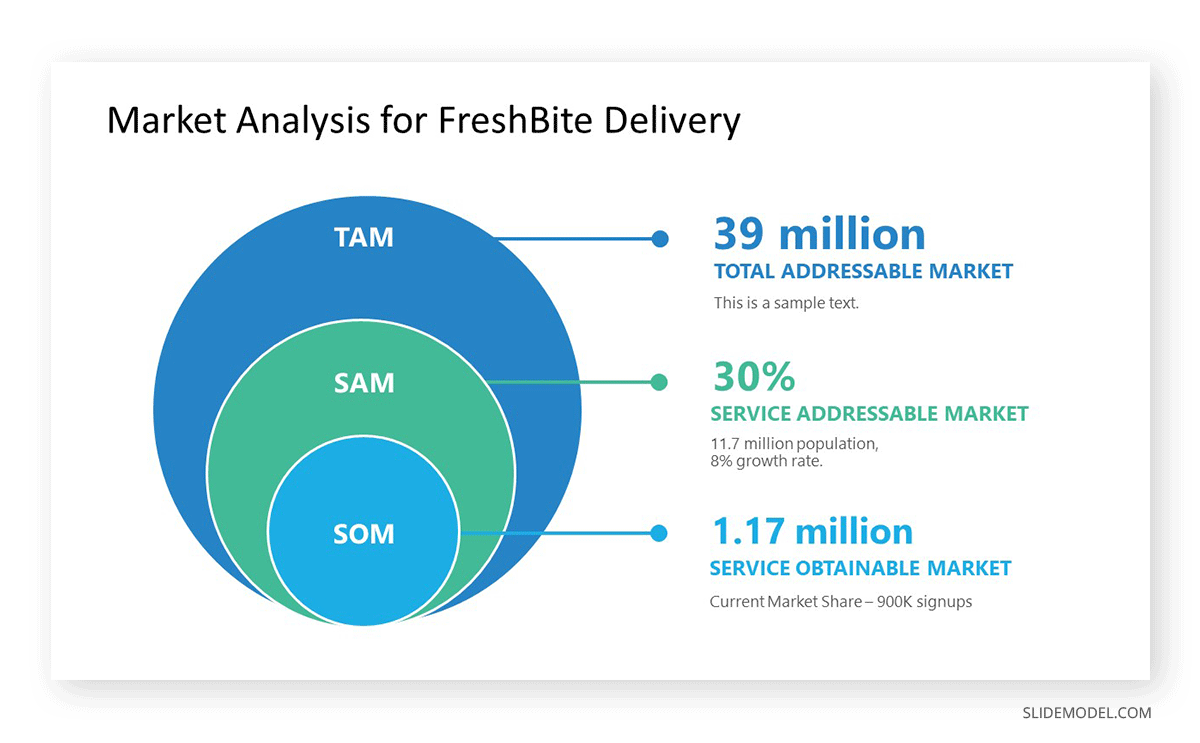
Another option presenters can consider is using a Perceptual Map to present the company’s position against competitors in the same market.
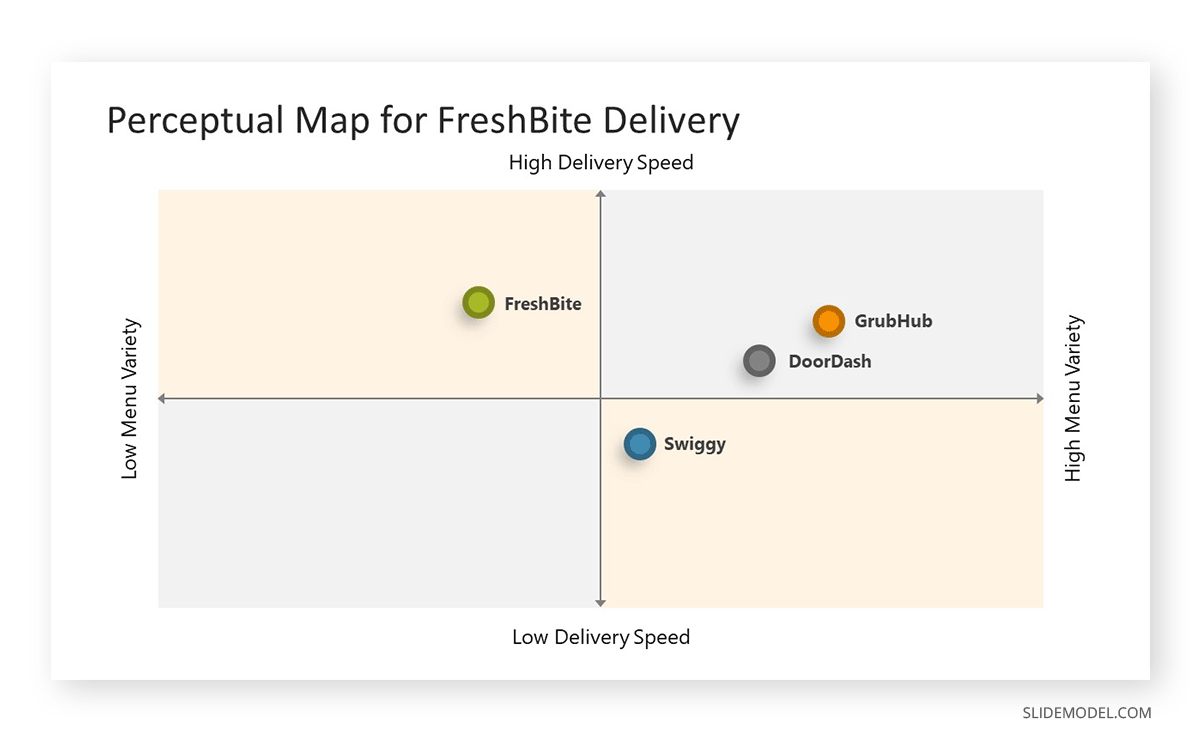
Now, it’s time to get into the nitty-gritty of your presentation by talking about your sales strategies and tactics. This part is the heart of your presentation, where you’ll outline the key activities you intend to implement to achieve your sales goals.
So, what should a sales strategy slide include? It should typically answer the following questions:
- How will we reach our target customers?
- Who is responsible for what?
- What’s the timeline for implementation?
Reaching Target Customers
This section zooms in on the methods and channels you’ll use to connect with your intended audience. Can you leverage social media, email campaigns, direct sales calls, or a mix of these approaches?
For example, the sales and marketing team of FreshBite Delivery may launch targeted advertising and search engine marketing campaigns to reach potential customers. They may also offer subscription discounts for long-term commitments to encourage repeat orders. All of these strategies are in line with their sales goal of increasing their monthly revenue.
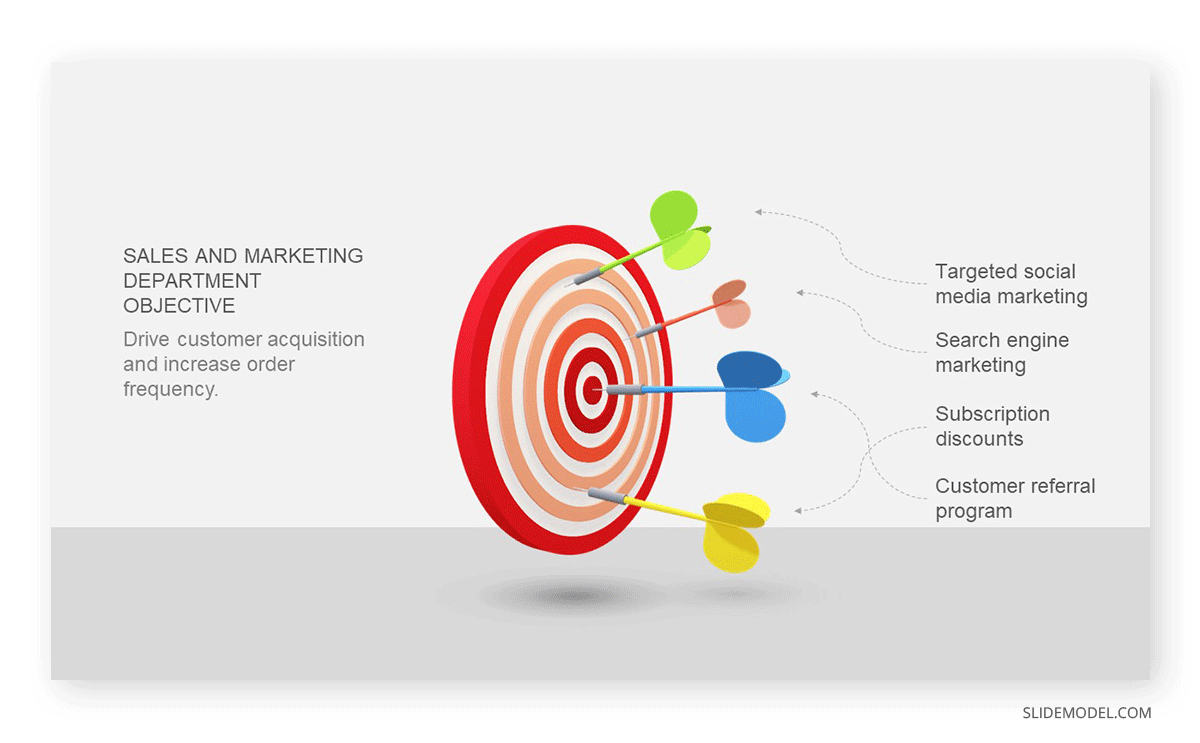
Presenting the Team
In your presentation, it’s also important to identify the individuals or teams who will be accountable for different aspects and execution of your sales plan. You’ll want to showcase the connections between individuals and their driving strategies. This demonstrates the coordinated effort that’s underway. Whether it’s the marketing team spearheading digital advertising or the customer support team nurturing customer relationships, this alignment of roles is the backbone of your sales success.
Setting Timelines
In this timeline slide , you will outline the actionable tasks contributing to achieving your sales goal with a clear completion timeline. Each task would be accompanied by its responsible party, a brief description, and a specific completion deadline. You may also list the activities in a way that assumes logical dependencies between tasks.
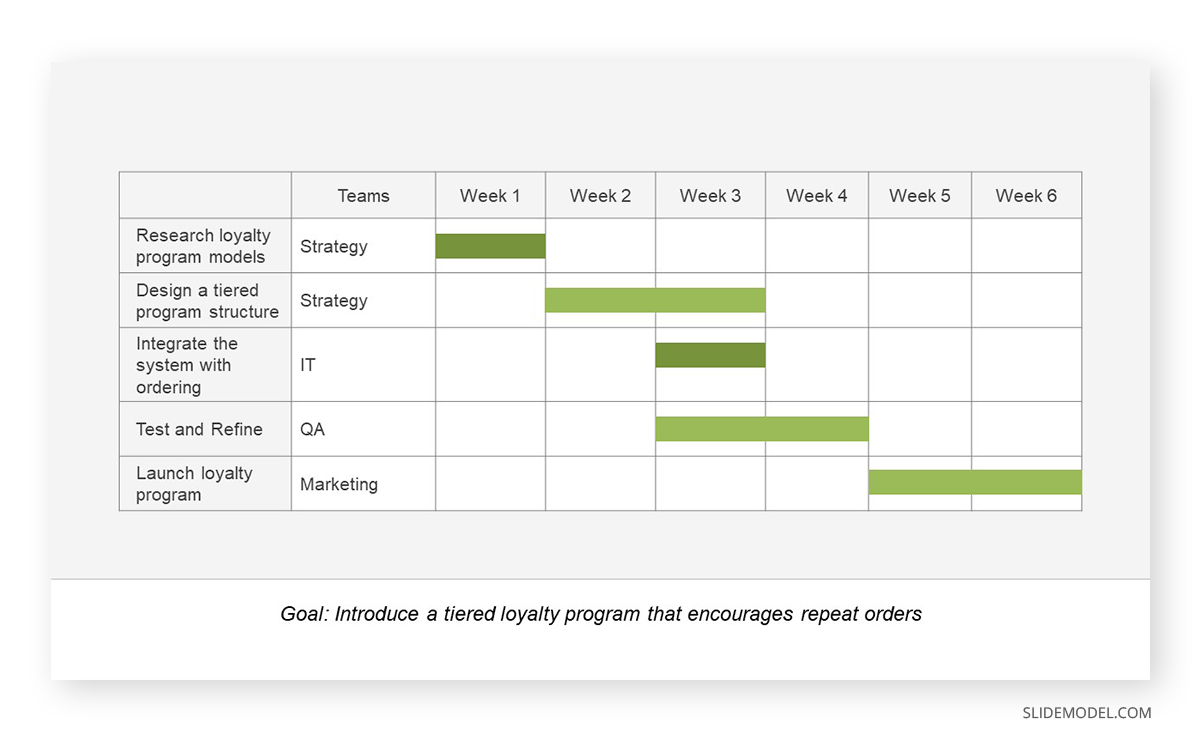
When presenting your sales plan to stakeholders, you outline your company’s growth roadmap. However, numbers speak louder than words, and a well-crafted financial projection serves as a quantitative validation of the strategic path you are advocating. This projection offers a calculated glimpse into the financial outcomes your sales initiatives are poised to generate.
In this section of your presentation, you may include the following:
- Sales Revenue Projection – an estimate of your expected sales revenue based on your sales strategies, market demand, and historical data.
- Sales Growth and Market Trends – anticipated market growth rates and trends that could impact your sales.
- Cash Flow Projection – a breakdown of the inflow and outflow of cash over a specific period.
- Break-Even Analysis – the point at which your total revenue equals your total expenses.
- Churn Rate – the proportion of customers who are leaving.
A sales plan aims to provide your organization with a systematic approach to achieving your revenue goals successfully. However, unforeseen incidents may catch you off guard and disrupt your plan’s progress. It’s paramount to let the stakeholders know that you have a “Plan B.”
According to Forbes Advisor , a contingency plan is a plan that will guide how your team should react to factors that interrupt the normal course of business. On the other hand, risk management is a broader approach focused on identifying and mitigating potential risks before they materialize into disruptions. Both concepts are crucial components of a sales plan.
Here’s a sample presentation of a contingency plan and risk management strategy for our made-up organization, FreshBite Delivery.

Tips for Sales Plan Presentations
1. keep your presentation concise.
When you present a wordy slide during a sales plan presentation with the stakeholders, a lot can go wrong. They may inadvertently read ahead or, worse, lose interest in the presentation altogether. Hence, you need to make a conscious effort to prioritize brevity and clarity in your slides.
One technique that can help you in this regard is the 1-6-6 rule, which suggests that there should only be one main idea for each slide, a maximum of six bullet points, and six words per bullet point.
Guy Kawasaki, on the other hand, suggests that an engaging presentation consists of no more than 10 slides, lasts no longer than 20 minutes, and is no lower than 30 points in size. This is known as the 10/20/30 rule of presentation .
2. Use Graphs, Charts, and Infographics
Sales plan presentations often include data-heavy information that visuals can convey more effectively than words alone.
For example, you can use a bar chart to compare revenue growth over quarters or a pie chart to showcase the percentage distribution of customer segments. You may also utilize a sales funnel to visualize the customer journey and the strategies you must implement for each stage.
Visual representations can simplify complex data, enhance comprehension, and make the information more engaging for your audience.
3. Create Narratives to Connect with the Audience
Stories are one of the most engaging ways to grab an audience and gain support for your strategies in the context of a sales plan presentation. A well-crafted story can illustrate the rationale behind your proposed plan and emotionally connect stakeholders to your vision.
Instead of directly stating your resource requirements, for example, you can weave a story highlighting employees’ challenges in completing a transaction. This demonstrates how these challenges affect revenue and explains why you need more resources to do better.
4. Anticipate Objections
Facing objections during a sales plan presentation can be nerve-wracking, but you can also use them to strengthen your case and increase stakeholder buy-in.
When faced with customer objections , what you need to do is to respond to the real issue. Shift the conversation towards potential solutions and showcase how your strategies address the concerns. Support your response with concrete evidence to add credibility to your arguments.
So, if a stakeholder objects to the potential risks of entering a competitive landscape, highlight your risk mitigation plan and cite market trends to prove that your strategies are grounded on tangible data.
5. Send Follow-Up Info
The next crucial step is to maintain momentum and solidify the impact of your presentation, which you can do by sending follow-up information.
You can start your follow-up email by thanking your audience and concisely summarizing the main points discussed in your presentation. You may also further address objections and reiterate how your strategies solve those concerns.
Don’t forget to attach the complete sales plan document to your email so your audience can revisit and study the content.
For more information, check our article about strategy presentations .
Crafting an effective sales plan presentation is paramount for achieving support and buy-in from your organization’s decision-makers. By meticulously analyzing market trends, setting clear goals, and transforming them into insightful presentation materials, your presentation becomes a potent tool for engaging stakeholders and realizing organizational objectives. Our presentation templates can help you level up the clarity of your proposals necessary to secure the backing you need for successful implementation.
1. Simple Executive Summary Slide Template for PowerPoint

You don’t have to go overboard to express the Executive Summary in a Sales Plan Presentation. Work with this visual one-pager slide with three colorful sections to showcase the main business objectives. Clipart icons help to add value to your presentation as visual cues of what the objective is oriented.
Use This Template
2. Executive Summary PowerPoint Template
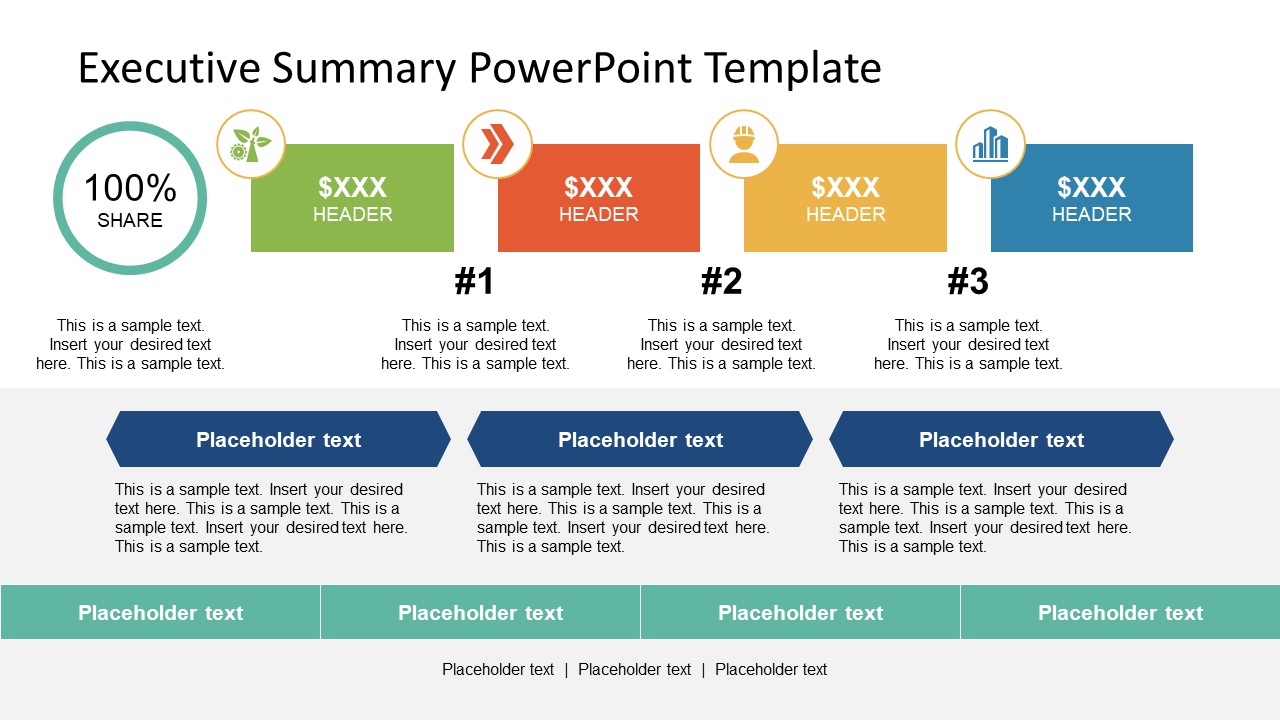
The Executive Summary slide used in the case study of this guide can be part of your upcoming sales plan presentation. This highly visual template is intended for QBR presentations, as it summarizes the business plan’s milestones, a market analysis, and strategies, and you can even include the company’s vision and operational processes.
Work with the included icons, and resize or reorganize the elements listed in this 100% editable executive summary slide deck.
3. Perceptual Map PowerPoint Template
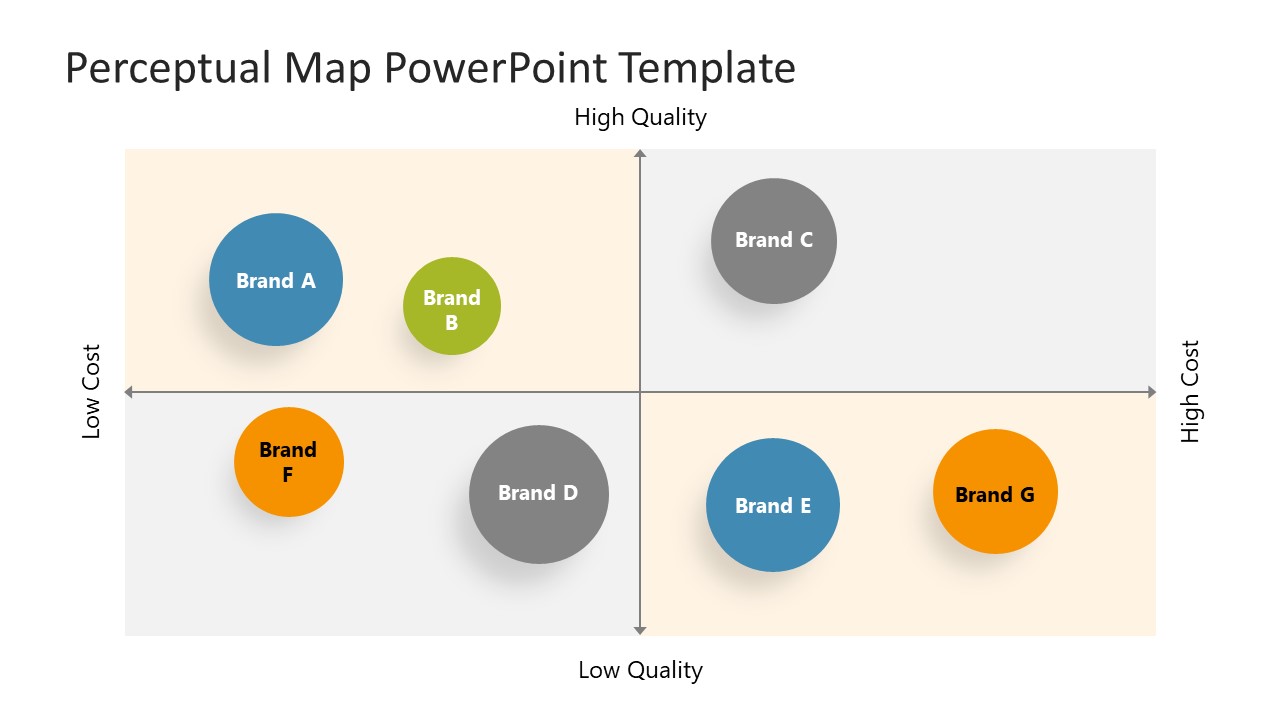
A selection of 3 layouts to express a Perceptual Map in your sales plan presentations. Using this tool, you can instantly map companies in how they rank according to two key attributes – such as price and quality.
This perceptual map template helps companies understand where their product or service stands in the market compared to other industry actors. Edit the included icons in terms of size, color, and positioning in just seconds.
4. Brand Positioning Map PowerPoint Template

An alternative to express a brand’s stance in the market, use this Brand Positioning Map PowerPoint template to analyze and present your brand against competitors in the same niche according to two ranking metrics. This two-axis map is expressed through multiple formats, such as a simple map diagram, a 3×3 matrix, a multi-map layout, and more. You can edit all details in this template, such as shapes and colors used to represent brands and their overall position.-
5. Member Profile PowerPoint Template
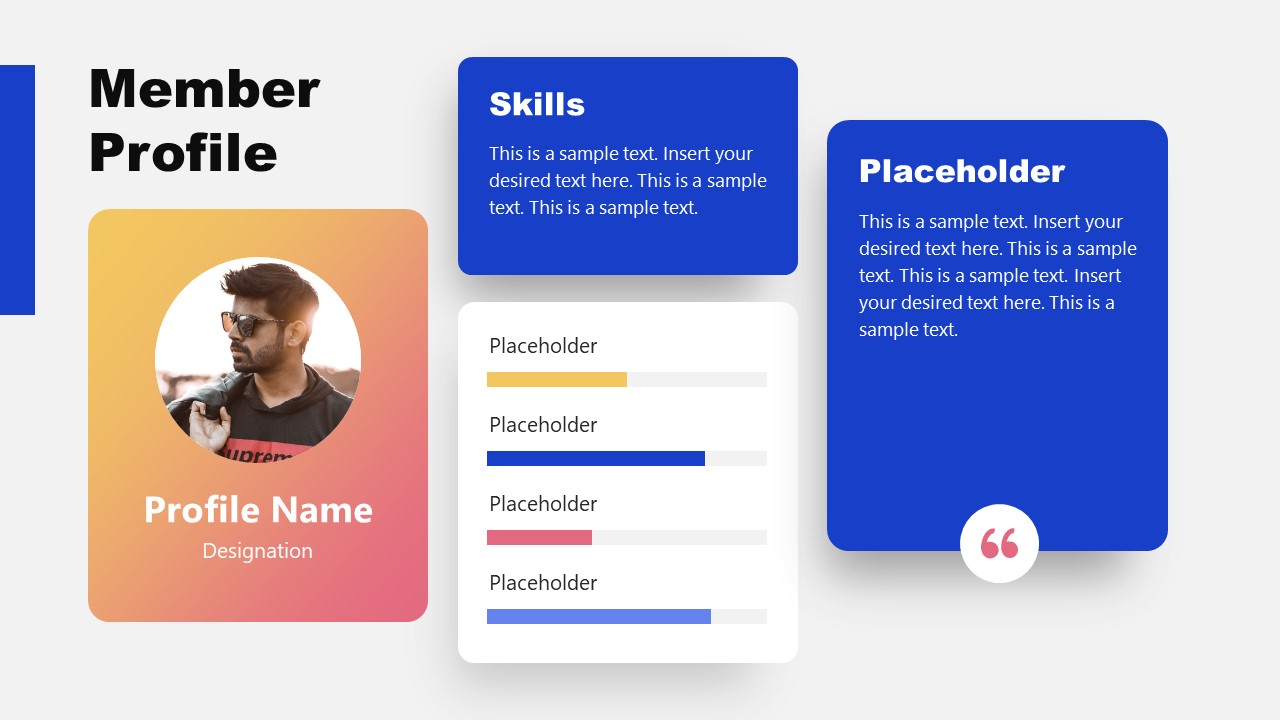
Introduce your team in a detailed format by highlighting their core skills in relation to your company’s sales plan. Using our Member Profile PowerPoint template, we can ditch the dull org chart slides and get your team closer to stakeholders in a layout resembling a website or social media profile.
Try and edit these 3 creative meet-the-team slides, and tailor their color scheme to your branding requirements in just a couple of clicks.
6. Editable Gantt Chart for PowerPoint
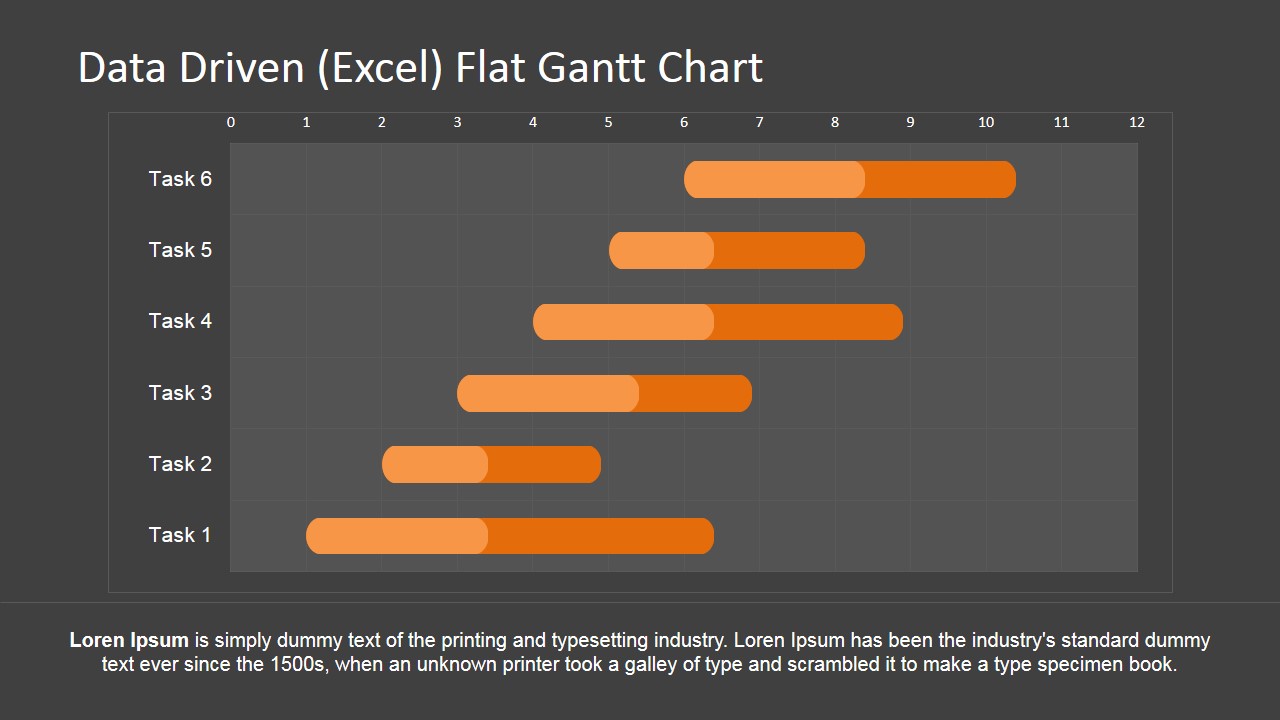
Express deadlines, overlapping tasks, and dependencies by using an elegant and simple Gantt Chart Template for PowerPoint. This fully editable template shall help you represent your tasks by using three main properties: Start Date, End Date, and Task Curation Percentage.
This template allows full customization of color, shape sizes, task count, time period, etc., to help presenters narrow down the core areas of their projects in an efficient format. Using a two-tone bar, this Gantt Chart stands out as a sort of 3D graphic, making it an attractive visual asset for your presentation.
7. Financial Projections & Key Metrics Template for PowerPoint

Represent the numbers managed in your financial projections in a visual format. This Financial Projections & Key Metrics Template for PowerPoint uses a table format that is fully editable to cover as many years as required or even lists other metrics than Customer Number, Revenue, Expenses, and Cash Flow.
Easy to update, the pre-made slides cover 2-year, 3-year, 4-year, and 5-year plan projections.
8. Sales Action Plan PowerPoint Template

Use this Sales Action Plan PowerPoint template to turn your sales goals into an actionable plan. The template features two slides with 3 columns for different sales channels: In-Store, Online, and Wholesale. Each slide is a variation of the layout, either in vertical or horizontal format.
List down the core elements of your action plan according to your KPIs, and measurement parameters like projected sales, deadlines, distribution strategy, and more.
9. 30 60 90 Days Plan Timeline Template

Your sales plan presentation can feature a 30-60-90 days Plan Timeline Template to express short-term actions and when is the expected deadline for them. We list five different layouts for this purpose, so presenters can easily adapt these slides to their graphics style.
10. Creative TAM SAM SOM Slides Template

An alternative to this article’s TAM SAM SOM slide, this pyramid format presents the market size subsets in a funnel layout. The usage of this tool is relevant to any business size but particularly relevant to small business owners to initiate their operations with the right selling strategy.
Use this template today and smartly create lead-generation strategies with these insights.
Like this article? Please share
Presentation Approaches, Sales Filed under Business
Related Articles

Filed under Business • July 24th, 2024
How to Create a Demo Presentation
Discover the secrets behind successful demo presentations and what they should contain with this article. Recommended PPT templates included.

Filed under Presentation Ideas • July 17th, 2024
How to Convert a Text Document into a Presentation with AI
One of the biggest challenges for presenters is to summarize content from lengthy reports, academic papers, or any other kind of written media in an informative and concise way. Rather than losing countless hours going over and over the same text, we can speed up the process thanks to the virtues of artificial intelligence. In […]
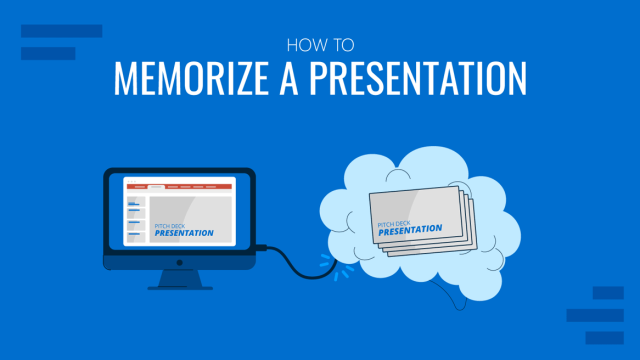
Filed under Education • July 10th, 2024
How to Memorize a Presentation: Guide + Templates
Become a proficient presenter by mastering the art of how to memorize a presentation. Nine different techniques + PPT templates here.
Leave a Reply
What is Sales Planning? How to Create a Sales Plan
Published: December 06, 2023
Sales planning is a fundamental component of sound selling. After all, you can‘t structure an effective sales effort if you don’t have, well, structure . Everyone — from the top to the bottom of a sales org — benefits from having solid, actionable, thoughtfully organized sales plans in place.

This kind of planning offers clarity and direction for your sales team — covering everything from the prospects you‘re trying to reach to the goals you’re trying to hit to the insight you're trying to deliver on.
But putting together one of these plans isn‘t always straightforward, so to help you out, I’ve compiled this detailed guide to sales planning — including expert-backed insight and examples — that will ensure your next sales plan is fundamentally sound and effective.
hbspt.cta._relativeUrls=true;hbspt.cta.load(53, 'b91f6ffc-9ab7-4b84-ba51-e70672d7796e', {"useNewLoader":"true","region":"na1"});
In this post, we'll cover:
What is a sales plan?
Sales planning process.
- What goes in a sales plan template?
How to Write a Sales Plan
Tips for creating an effective sales plan, sales plan examples, strategic sales plan examples.
A sales plan lays out your objectives, high-level tactics, target audience, and potential obstacles. It's like a traditional business plan but focuses specifically on your sales strategy. A business plan lays out your goals — a sales plan describes exactly how you'll make those happen.
Sales plans often include information about the business's target customers, revenue goals, team structure, and the strategies and resources necessary for achieving its targets.
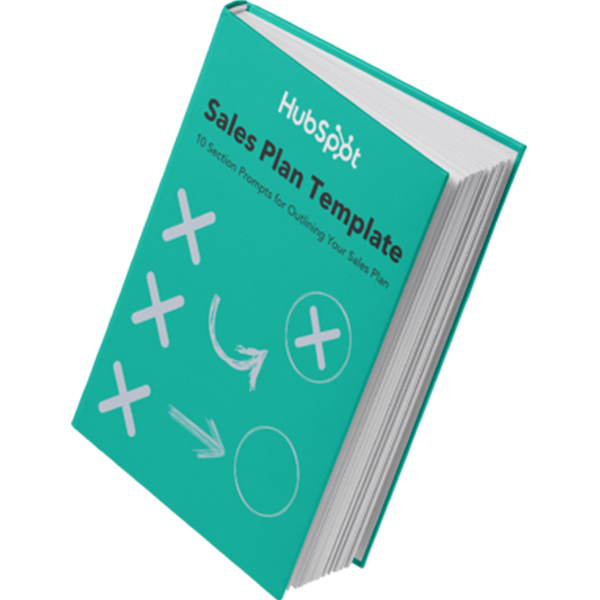
Free Sales Plan Template
Outline your company's sales strategy in one simple, coherent sales plan.
- Target Market
- Prospecting Strategy
Download Free
All fields are required.
You're all set!
Click this link to access this resource at any time.
What are the goals of an effective sales plan?
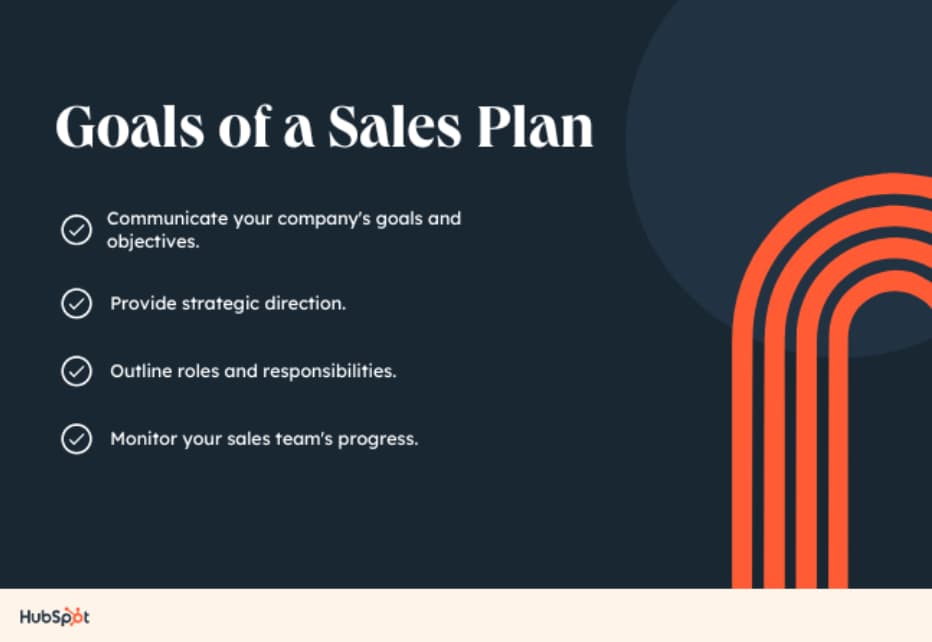
And if (or more likely when ) those goals change over time, you need to regularly communicate those shifts and the strategic adjustments that come with them to your team.
Your sales strategy keeps your sales process productive — it offers the actionable steps your reps can take to deliver on your vision and realize the goals you set. So naturally, you need to communicate it effectively. A sales plan offers a solid resource for that.
For instance, your sales org might notice that your SDRs are posting lackluster cold call conversion rates. In turn, you might want to have them focus primarily on email outreach, or you could experiment with new sales messaging on calls.
Regardless of how you want to approach the situation, a thoughtfully structured sales plan will give both you and your reps a high-level perspective that would inform more cohesive, effective efforts across the team.
An effective sales org is a machine — one where each part has a specific function that serves a specific purpose that needs to be executed in a specific fashion. That's why everyone who comprises that org needs to have a clear understanding of how they specifically play into the company's broader sales strategy.
Outlining roles and responsibilities while sales planning lends itself to more efficient task delegation, improved collaboration, overlap reduction, and increased accountability. All of which amount to more streamlined, smooth, successful sales efforts.
Sales planning can set the framework for gauging how well your team is delivering on your sales strategy. It can inform the benchmarks and milestones reps can use to see how their performance stacks up against your goals and expectations.
It also gives sales leadership a holistic view of how well a sales org is functioning as a whole — giving them the necessary perspective to understand whether they have the right people and tools in place to be as successful as possible.
Sales planning isn‘t (and shouldn’t) be limited to the actual sales plan document it produces. If that document is going to have any substance or practical value, it needs to be the byproduct of a thorough, well-informed, high-level strategy.
When sales planning, you have some key steps you need to cover — including:
- Gather sales data and search for trends.
- Define your objectives.
- Determine metrics for success.
- Assess the current situation.
- Start sales forecasting.
- Identify gaps.
- Ideate new initiatives.
- Involve stakeholders.
- Outline action items.
When putting this list together, I consulted Zach Drollinger — Senior Director of Sales at edtech provider Coursedog — to ensure the examples detailed below are sound and accurate.
Step 1: Gather sales data and search for trends.
To plan for the present and future, your company needs to look to the past. What did sales look like during the previous year? What about the last five years? Using this information can help you identify trends in your industry. While it's not foolproof, it helps establish a foundation for your sales planning process.
For the sake of example, let‘s say that I’m a new sales director for an edtech company that sells curriculum planning software to higher education institutions. My vertical is community colleges, and my territory is the East Coast.
Once I assume this new role, I‘m going to want to gather as much context as possible about my vertical and how my company has approached it historically. I would pull information about how we’ve sold to this vertical.
How much new business have we closed within it in the past five years? How does that compare to how we perform with other kinds of institutions? Are we seeing significant churn from these customers?
I would also want to get context about the general needs, interests, and pain points of the kinds of institutions I‘m selling to. I’d look for insight into figures like degree velocity, staff retention, and enrollment.
Ultimately, I would get a comprehensive perspective on my sales process — a thorough understanding of where I stand and what my prospects are dealing with. That will ensure that I can deliver on the next step as effectively as possible.
Step 2: Define your objectives.
How do you know your business is doing well if you have no goals? As you can tell from its placement on this list, defining your goals and objectives is one of the first steps you should take in your sales planning process. Once you have them defined, you can move forward with executing them.
To extend the example from the previous step, I would leverage the context I gathered through the research I conducted about both my and my prospect's circumstances. I would start setting both broader goals and more granular operational objectives .
For instance, I might want to set a goal of increasing sales revenue from my vertical. From there, I would start putting together the kind of specific objectives that will facilitate that process — like connecting with administrators from at least 30 community colleges, booking demos with at least 10 schools, and successfully closing at least five institutions.
Obviously, those steps represent a streamlined (and unrealistically straightforward) sales process, but you get the idea — I would set a concrete goal, supplemented by SMART objectives , that will serve as a solid reference point for my org's efforts as the sales process progresses.
Step 3: Determine metrics for success.
Every business is different. One thing we can all agree on is that you need metrics for success. These metrics are key performance indicators (KPIs). What are you going to use to determine if your business is successful? KPIs differ based on your medium, but standard metrics are gross profit margins, return on investment (ROI), daily web traffic users, conversion rate, and more.
I kind of covered this step in the previous example, but it still warrants a bit more elaboration. The “M” in SMART goals (“measurable”) is there for a reason. You can‘t tell if your efforts were successful if you don’t know what “successful” actually means.
The edtech sales example I‘ve been running with revolves mostly around me assuming ownership of an existing vertical and getting more out of it. So it’s fair to assume that sales growth rate — the increase or decrease of sales revenue in a given period, typically expressed as a percentage — would be an effective way to gauge success.
I might want to structure my goals and objectives around a sales growth rate of 20% Y/Y within my vertical. I would make sure my org was familiar with that figure and offer some context about what it would take to reach it — namely, how many institutions we would need to close and retain.
Step 4: Assess the current situation.
How is your business fairing right now? This information is relevant to determining how your current situation holds up to the goals and objectives you set during step two. What are your roadblocks? What are your strengths? Create a list of the obstacles hindering your success. Identify the assets you can use as an advantage. These factors will guide you as you build your sales plan.
Continuing the edtech example, I would use the historical context I gathered and the objectives I set to frame how I look at my current circumstances. I might start by considering my goal of increasing revenue by 20% Y/Y. In that case, I would look at the company's retention figures — ideally, that would give me a sense of whether that needs to be a major area of focus.
I would also try to pin down trends in the colleges that we've already closed — are there any pain points we consistently sell on? I might take a closer look at how we demo to see if we might be glossing over key elements of our value proposition. Maybe, I would use conversation intelligence to get a better sense of how reps are handling their calls.
Ultimately, I would try to identify why we're performing the way we are, the inefficiencies that might be resulting from our current strategy, and how we can best set ourselves up to sell as effectively as possible.
Step 5: Start sales forecasting.
Sales forecasting is an in-depth report that predicts what a salesperson, team, or company will sell weekly, monthly, quarterly, or annually. While it is finicky, it can help your company make better decisions when hiring, budgeting, prospecting, and setting goals.
After the COVID-19 pandemic, economics has become less predictable. Claire Fenton , the owner of StrActGro — a professional training and coaching company — states, “Many economic forecasters won't predict beyond three months at a time.” This makes sales forecasting difficult. However, there are tools at your disposal to create accurate sales forecasts .
In our edtech example, I would approach this step by trying to estimate how my sales org is going to fare with the specific vertical we‘re pursuing in the time window we’ve allotted.
The method I decide to go with will depend on factors like how many concrete opportunities we have lined up — in addition to elements like the kind of historical data we have handy, how the reps working these deals tend to perform, and the degree of insight we have about our potential customers.
Let's say I consider those factors and decide to run something called a multivariable analysis. In that case, I could start by taking stock of the opportunities my reps have lined up. Then, I could look at the reps working those deals, their typical win rates, and the time they have to close — among other factors.
For instance, I might calculate that a rep working with a particularly large institution has a 50% chance of closing within the window we‘ve allotted. Using that insight, we could attribute 50% of the potential deal size to our forecast — we’d repeat that process with all of the opportunities in question and ideally get a solid sense of the revenue we can expect to generate in this window.
Step 6: Identify gaps.
When identifying gaps in your business, consider what your company needs now and what you might need in the future. First, identify the skills you feel your employees need to reach your goal. Second, evaluate the skills of your current employees. Once you have this information, you can train employees or hire new ones to fill the gaps.
Continuing the edtech example, let‘s say my forecast turned up results that weren’t in keeping with what we need to reach our goals. If that were the case, I would take a holistic look at our process, operations, and resources to pin down inefficiencies or areas for improvement.
In my search, I find that our sales content and marketing collateral are dated — with case studies that don‘t cover our product’s newest and most relevant features. I also might see that our reps don‘t seem to have too much trouble booking demos, but the demos themselves aren’t converting due to a lack of training and inconsistent messaging.
And finally, I find that a lack of alignment with marketing has prospects focusing on unrealistic outcomes our sales team can‘t deliver on. Once I’ve identified those gaps, I would start to hone in on ways to remedy those issues and improve those elements.
Step 7: Ideate new initiatives.
Many industry trends are cyclical. They phase in and out of “style.” As you build your sales plan, ideate new initiatives based on opportunities you may have passed on in previous years.
If your business exclusively focused on word-of-mouth and social media marketing in the past, consider adding webinars or special promotions to your plan.
In the edtech example we've been running with, I would likely ideate initiatives based on the gaps I identified in the previous step. I would start a push to ensure that our sales content and marketing collateral are up-to-date and impressive.
I would also consider new training programs to ensure that our coaching infrastructure is prioritizing how to conduct effective demos. Finally, I would start to work on a plan with marketing to ensure our messaging is aligned with theirs — so we can make sure prospects' expectations are realistic and effective.
One way or another, I would take the gaps I found and find concrete, actionable ways to fill them. I would make sure that these initiatives aren't abstract. Just saying, " We're going to be better at demos," isn‘t a plan — it’s a sentiment, and sentiments don't translate to hard sales.
Step 8: Involve stakeholders.
Stakeholders are individuals, groups, or organizations with a vested interest in your company. They are typically investors, employees, or customers and often have deciding power in your business. Towards the end of your sales planning process, involve stakeholders from departments that affect your outcomes, such as marketing and product. It leads to an efficient and actionable sales planning process.
This step is sort of an extension of the previous two — once I‘ve identified the key issues and roadblocks obstructing my edtech startup’s sales org, I would start identifying the right people to fulfill the necessary initiatives I've put together.
In this example, I would tap some stakeholders in charge of our sales content and marketing collateral to produce newer, more relevant case studies and whitepapers we can pass along to the institutions we're working with.
I would also go to middle management and either offer more direction for coaching on demos or bring in a third-party training service to offer more focused, professional insight on the issue.
Finally, I would connect with marketing leadership to align on the benefits and outcomes we generally stress when pitching the schools we sell to. That way, we can ensure that the institutions we're connecting with have realistic expectations of our product or service that we can speak to more clearly and effectively.
Step 9: Outline action items.
Once you have implemented this strategy to create your sales planning process, the final step is outlining your action items. Using your company's capacity and quota numbers, build a list of steps that take you through the sales process. Examples of action items are writing a sales call script, identifying industry competitors, or strategizing new incentives or perks.
In our edtech example, some key action items might be:
- Revamp our prospecting strategy via more involved coaching and re-tooled sales messaging.
- Revamp administrator and college dean buyer personas.
- Conduct new trainings on demoing our software.
- See our new prospecting strategy from ideation to execution.
- Align with our sales enablement stakeholders for new, more relevant case studies and whitepapers.
Obviously, that list isn‘t exhaustive — but those are still the kinds of steps we would need to clarify and take to structure a more effective high-level strategy to produce different (ideally much better) results than we’ve been seeing.
One thing to keep in mind is that sales planning shouldn't end with creating the document.
You‘ll want to reiterate this process every year to maintain your organization's sales excellence.
Now that you‘re committed to the sales planning process, let's dive into the written execution component of sales planning.
Featured Resource: Sales Plan Template

6. Sales Strategy Diagram from Creately
Don't forget to share this post!
Related articles.

The Power of AI in Sales & 7 Ways You Can Use It in 2024

What is a Sales Funnel? (& What You Should Make Instead)

Outcome-Based Selling: An Overview + Practical Tips

The Ins & Outs of Cold Emailing That Delivers Results
![presentation for sales plan What Is Cross-Selling? Intro, Steps, and Pro Tips [+Data]](https://knowledge.hubspot.com/hubfs/ft-cross-selling.webp)
What Is Cross-Selling? Intro, Steps, and Pro Tips [+Data]

Company Growth Strategy: 7 Key Steps for Business Growth & Expansion

9 Bad Sales Habits (& How to Break Them In 2024), According to Sales Leaders
![presentation for sales plan 22 Best Sales Strategies, Plans, & Initiatives for Success [Templates]](https://www.hubspot.com/hubfs/Best-Sales-Strategies-1.png)
22 Best Sales Strategies, Plans, & Initiatives for Success [Templates]

9 Key Social Selling Tips, According to Experts
![presentation for sales plan 7 Social Selling Trends to Leverage This Year [New Data]](https://www.hubspot.com/hubfs/social%20selling%20trends.png)
7 Social Selling Trends to Leverage This Year [New Data]
Outline your company's sales strategy in one simple, coherent plan.
Powerful and easy-to-use sales software that drives productivity, enables customer connection, and supports growing sales orgs
No results found.
Sales presentations: templates, examples and ideas on how to present like a pro

A good sales presentation is more than a simple pitch, a demo or a list of facts and figures. Done well, at the right time in your sales process , it’s a tool for getting your prospects’ attention, drumming up excitement and moving prospects toward a buying decision.
In this guide, you’ll learn how to use the power of storytelling to drive decision-making and close more deals. We’ll also cover the fundamental elements of an effective sales presentation strategy, what to include in your sales decks and practical ideas on how to deliver them.
What is a sales presentation?
A sales presentation is a live meeting where your team showcases your product or service and why it’s the best option for your prospect.
Although the terminology differs from company to company, a sales presentation is not always the same as a sales pitch.
A sales pitch is what your sales professionals do all day long, on the phone, over Zoom or in person with clients.
A sales presentation (although it’s still a sales pitch) is a point-in-time event that usually happens when your sales team is trying to close a more lucrative deal. It’s not a simple phone call, as it often involves a meeting and a demo.
Because you’re likely presenting to a group of senior decision-makers and executives, sales presentations require ample prep time and coordination across multiple team members.
Key takeaways from this sales presentations article
Deliver effective presentations: Make your sales presentations compelling with storytelling, effective slide decks, tailored content and strong delivery techniques. Benefits of great presentations: Sales presentations grab attention, excite prospects and drive decision-making, helping close more deals by showcasing your product’s value. Pipedrive’s tools, including customizable sales dashboards and Smart Docs , help you create professional, tailored presentations that enhance your sales strategy. Try Pipedrive free for 14 days .
How (and why) to use storytelling in your sales presentation
Use stories in your presentations to help people remember and relate to your brand.
Statistics, facts and figures can help when you’re trying to persuade a prospect to become a customer, but they’re more impactful if you can frame them with a memorable story.
For example, tell a story about a customer who faced the same challenges as your prospect and supplement it with powerful data, they are more likely to listen and want to know more.
Human beings have a deep relationship with storytelling. Stories move, teach and, in a sales context, persuade audiences.
Chip Heath, a Stanford professor and the co-author of Made to Stick , demonstrates the importance of storytelling by doing an exercise with his students. He divides them into groups and asks them to deliver a one-minute persuasive pitch based on data he’s just shown them.
After the pitches are delivered, he asks the class to jot down everything they remember about them. Although most students use stats rather than stories, 63% remember the stories, while only 5% remember an individual data point .
The stickiness of stories makes them a useful tool for developing a sales presentation outline. They help prospects understand and remember the key points of the presentation and your product.
Thomas Dredge Sales Manager, Particular Audience
Start with a problem (and a deadline)
Your presentation is about the solution you’re offering your prospects, but it shouldn’t start with that solution.
Instead, lead with the problem your solution was designed to solve.
“ Value selling is key,” says Bradley Davies, business development at Cognism . “It is important to understand your buyer and tailor their journey to what you can do for them.
“First, you need to understand what is motivating them to have a discussion, which allows you to identify their pains and present how your offering solves their pains. Everything presented to a prospect should be based on the value for them specifically.”
You might choose to tell a story that positions your product as the hero, helping the customer vanquish a villain: their pain point.
Your story should be tailored to the pain points of the prospects in the room. For example, a change to their business, industry or the technology they use.
“If an element of your offering is not relevant, then don't distract them from the important features. It will keep them engaged and help to build their user story,” adds Bradley.
Recommended reading

Digging deep to determine customer pain points and make the sale
Create a sense of urgency around your product: It’s a solution to their problem, but if they don’t act now, they could miss an opportunity. Tell a story about what might happen if your prospect doesn’t change, framing the consequences of inaction.
Focus on outcomes
You’ve outlined the problem and, if you’re doing your job, your audience is nodding along. Now it’s time to start talking about the solution.
However, that doesn’t mean you should launch into the features and benefits of your product just yet.
Rather than presenting your product, a good sales presentation draws a picture of what life could look like for a customer once they start doing things differently. How will their workload or productivity improve? What will they be able to do with additional time and resources? How will they reduce spending and increase revenue?
From there, introduce your solution and the features that can make this brave new world possible. Do this in a few ways:
Position your features against the old way of doing things
Present those features as “superpowers” that will solve your prospect’s problems
Compare those features to competitors’ features
Quantify the value your features bring vs. the cost of doing nothing
Use a combination of some or all of the above
Creating a winning sales presentation slide deck
Most sales presentations include a slide deck to deliver facts, case studies and statistics that convey the value of your solution.
Create your sales pitch deck in an application like PowerPoint or Google slides to ensure your presentation is visible to everyone in the room (or in a virtual setting).
The best sales decks have a few key elements:
A great cover image or opening slide. Like the story you open your presentation with, your cover slide should grab your audience’s attention.
Data and key points . Charts, graphs, infographics, quotes and other information back up your presentation. Your slides should support your presentation by visualizing data, not repeating what you’re saying. You can get metrics from third-party sources or (if appropriate) from your own sales dashboard .
Testimonials and case studies from other customers. Quotes and success stories from or information about other customers, preferably in the same industry as your prospects, will act as social proof and go a long way to backing up your claims.
Competitive context. In all likelihood, your product isn’t the only one a potential customer is evaluating. Savvy sales professionals take the opportunity to proactively communicate how their product stacks up to their competitors’ and anticipate objections.
Customized content. While it might seem tempting to use the same content for every presentation, you should personalize your presentation for each meeting. You might want to use your prospect’s brand colors, find data specific to their market or industry, or reference an earlier exchange. You can find ready-to-use customizable sales decks through a graphic design app, such as Canva.
A glimpse into next steps. Give your prospects an understanding of what new customer onboarding looks like with a slide that includes a direct call to action offering next steps. For some companies, the training and customer support experience can be a value proposition in and of itself.
A note about text in your sales deck : Keep the slides simple and light on text. Your prospects don’t want to look at a wall of words to read. According to data from Venngage , 84% of presenters use visual data in their presentations – and for good reason: You don’t want to overwhelm your audience with text as they listen to you, look at your sales deck and watch the demo.
When you do include text, ensure you use a font (and font size) that can be easily read by everyone sitting in on your presentation.
Download the Sales Presentation Templates ebook
Your data is processed according to our privacy notice . You may unsubscribe at any time.
What else to bring to your sales presentation
Now that we’ve discussed the story elements of a sales presentation and your slide deck, what else should you bring to the meeting?
Most sales presentations are in-person affairs and include visual elements like a sales deck, handouts or even an in-person demonstration of the physical product. Here are a few things to think about including in your pitch.

13 examples of sales collateral you need to drive revenue
The product.
Nothing sells a product like seeing it in action.
Take Scrub Daddy, a sponge that changes shape depending on the heat of the water. When Aaron Krause, Scrub Daddy’s founder and inventor, presented the product on Shark Tank in 2012 , he demonstrated the sponge cleaning dirty kitchenware and greasy countertops. He also used bowls of water and two 10-pound weights to show the sponge’s amazing morphic abilities.
The tactic paid off: Scrub Daddy partnered with Lori Greiner for $200,000, in return for 20% equity in the business and is now considered one of Shark Tank’s most successful products.
Not all products are easy to demo, so you may have to improvise.
With a physical product, think of the perfect environment for a demo. What would show the product at its best?
With a digital product, make sure you have the technology on hand to show what your product can do (and check beforehand that the tech works). If it’s a mobile app, have your prospects download it. If it’s a platform, consider producing recorded or interactive product demos that can be embedded in your sales presentation.
For items that are too big to be brought in or which are location-specific, you may have to rely on a video as part of the presentation.

7 steps to putting together a brilliant sales demo
Leave behinds.
Depending on the nature of your solution, you may want to have materials you can leave with the prospects in the room.
This can be as simple as contact information or sales literature you pass out at the end of the presentation. It can also be something that’s part of the presentation, like a QR code that allows them to download the demo on their phones. Whatever format you choose, make sure the material is concise and to the point.
Tailoring your sales presentation to speak to your audience
Once you develop a strong sales deck template, it’s tempting to use it over and over with your target audience. Remember, personalization is essential in sales.
During lead generation , prospecting and sales calls, you know that prospects are more interested in buying if your pitches are tailored to them. It’s the same with your sales presentations, especially if you have an unusual prospect.
Let’s say your product is a CRM that’s normally used by sales organizations, but a human resources department is interested in using it to create a recruiting pipeline.
You wouldn’t use a sales deck with sales-related examples to sell it during the presentation.
Instead, you’d research talent acquisition challenges, ask your product department to create a template or a demo aimed at recruiting and build your sales deck accordingly.
Different industries have unique challenges and opportunities. It’s your responsibility to tailor your value proposition and key bullet points accordingly.
“To craft the perfect sales presentation pitch,” advises Danny Hayward, Sales Manager at Unruly , “ensure you take care of these three things:
Ask the right questions beforehand to understand the needs of the client, especially their flaws
Learn your product inside and out
Rehearse, rehearse and rehearse again
Danny Hayward Sales Manager, Unruly
How to nail your sales presentation delivery
Here are a few tried and true sales presentation techniques to make sure you close the deal.
Whether you’re presenting solo or as part of a team, it’s important to plan in advance. Follow these sales presentation tips for preparation.
Practice, practice, practice . You’ll need to get the timing right, especially if your presentation has a lot of moving parts. Go through it to make sure your timing works, so that you can nail the meeting itself.
Make sure everything works . You don’t want to go into a meeting with a faulty PowerPoint presentation or a broken sample – or find out there is no whiteboard when one is integral to your demonstration. Do your best to make sure everything goes to plan.
Decide on everyone’s roles . This one is just for those presenting as a team. Will different sales reps speak through each section? Will one rep talk while the others handle the sales deck and demo? Decide who will do and say what ahead of time.
Know your attendees. Make sure you know who from the prospect company will be in the meeting, their titles and the roles they each play in the buying process. Conducting light social media research can also clue you into attendees’ past experiences or alma maters (information that can fuel pre-presentation small talk and forge closer connections with your audience).
Practice confident body language
Presentations usually happen in person, which is why you need to practice strong body language. You want to look relaxed and confident (even if you’re shaking in your shoes).
Here are some ways you can improve your body language:
Eye contact . Make and maintain eye contact, even in virtual meetings. This shows people you’re interested in them and invested in what they have to say.
Stand up straight . Pull your shoulders back and straighten your spine; fixing your posture is an easy way to convey confidence. You’ll also feel better if you’re not hunched over.
Chin up. It’s hard when you’re in front of people, but don’t look at the floor or your shoes. Face straight ahead and make eye contact (or look at the back wall rather than the floor.)
Have a firm handshake. Some people judge others by their handshakes. Offer a firm handshake to make a good first impression.
Engage your audience
Presentations can span 30 to 60 minutes or more, so you need to be able to hold your prospects’ attention. There are a number of ways to keep everyone interested:
1. Understand your audience’s attention span
The beginning and the end of your presentation are the most memorable, so that’s where you want to use your strongest material.
Rather than leading with your product’s features, use the first few minutes of a presentation to briefly introduce yourself, and share the compelling story we mentioned earlier. If your demo itself is compelling, lead with that.
Then talk about product features and pricing. Your prospects might have already researched it or can look it up afterward, so it’s fine that it’s occupying real estate in the middle of the presentation.
Lastly, finish strong. Return to your story, sharing how your product solved an important problem. Close with confidence, and open the floor for questions.
2. Be funny
Humor can be tricky, so if you’re not comfortable making jokes, don’t force it. If, however, humor is part of your brand voice and you think it will be well-received by your audience, go for it. Humor can be a good way to connect with prospects, make your presentation memorable and relax everyone in the room.
3. Use a little showmanship
The best thing about a sales presentation is that it lets you show off your product. Unlike a pitch, a presentation lets you pull out the stops, make a splash and showcase your solution.
Use this to your advantage and be as memorable as you possibly can.
Sophie Cameron Business Development Representative, CAKE
What to do after the sales presentation to close the deal
The sales cycle isn’t over when the sales presentation ends. Here are some tips on how to wrap up loose ends and close the deal.
Take questions
Encourage questions to show prospects you care about their experience.
Sometimes prospects may want a question answered right in the middle of a presentation. Interactivity is a great sign of engagement. If that happens, stop the presentation and take their questions head-on to show you’re listening and validate their thoughts.
Other times they may sit silently waiting for you to give them all the information they need.
In either case, proactively ask for questions once you’ve ended your presentation. Encourage them to share their concerns. This is a consultative selling approach that works to build a relationship with your prospects.
By the end of your sales pitch, your prospect should be ready to come along with you and start your business relationship.
Outline the next steps of the process. The first could be offering a trial of your product, scheduling a follow-up meeting or sending over a proposal.
Whatever the steps, make sure they’re clearly defined. If you don’t hear from the prospect soon after the proposal, check back in with a follow-up email or call.

How to write a response-worthy follow-up email (with 15 templates)
Great sales presentation examples (and why they worked)
Here are some sales pitch examples you can use to inform your next sales presentation; these examples range from great sales decks to presentations and we’ll explain why they worked so well.
The successful demo
Stephen Conway of vegan chocolate brand Pure Heavenly opened his elevator pitch on the UK’s Dragons’ Den in 2019 by handing out samples of his chocolate. The product, paired with Stephen’s story about wanting to create an allergen-free treat that his young daughters could enjoy, led to three offers.
Why it worked: Conway knew the strength of his product and packaged it in a personal story, betting (correctly) that it would sell itself.
The data-driven presentation
Lunchbox is a restaurant technology company that specializes in online ordering, customer loyalty and guest engagement software. The sales deck the company used to raise its $50 million Series B in 2022 relied on bold visuals and graphs to illustrate its market opportunity, ARR history and competitive differentiators.

Why it worked: The deck tells two stories, one about the company itself and another about the way consumer dining habits have changed in the wake of COVID-19. Lunchbox used data to show how it met the industry’s new pain points for both itself and other companies.

Sales data: How to analyze sales data and a sample Excel spreadsheet
The presenters with overwhelming confidence
When Brian and Michael Speciale went on Shark Tank in 2017 to pitch their product, The Original Comfy, they had very little – no numbers or inventory, just a prototype of a big fleece blanket/hoodie and video of that hoodie being worn everywhere from the couch to the beach. What they did have was a good product and confidence in that product. Their presentation earned them an offer of $50,000 for 30% from Barbara Corcoran.
Why it worked: Corcoran says she bought in because the Speciale brothers had a good idea, the guts to present it and knew they had to strike while the iron was hot. While you probably should be more prepared for your own sales presentation, the Original Comfy story shows just how important confidence is in a sales presentation.
Begin your sales presentation by capturing your audience’s attention and establishing a solid foundation for the rest of your presentation. Here are some steps to consider:
Greet and introduce yourself
Establish rapport
State the purpose and agenda
Address the pain points
Present a compelling hook
Outline the benefits
Establish credibility
Set expectations
Remember to maintain a confident and enthusiastic demeanor throughout your presentation.
The ideal length of a sales presentation can vary depending on factors such as the complexity of the product or service, the audience’s attention span and the context in which the presentation is being delivered. However, keeping a sales presentation concise, focused and within the timeframe is generally recommended.
The conclusion of a sales presentation is a significant opportunity to leave a lasting impression and inspire action from your audience. Here are a few steps you should take to end your presentation effectively.
Include a call to action
Summarize key points
Showcase success stories
Open the floor to questions
Offer additional resources
Here’s an example of how to end your presentation:
“To quickly recap, we’ve covered these key points today: [Summarize the main features and benefits briefly].
“Now, let’s revisit our success stories. Our clients, like [Client A] and [Client B], achieved [mention their specific results]. These successes demonstrate how our product/service can deliver tangible benefits for your business.
“I’d be happy to address any questions or concerns you may have. Please feel free to ask about anything related to our offering, implementation process or pricing.
“Before we finish, I’d like to encourage you to take the next step. Schedule a demo, request a trial or start a conversation with our team. Don’t miss the opportunity to experience the advantages firsthand.
“Lastly, we have additional resources available, such as case studies and whitepapers, to provide you with more insights. Feel free to reach out to our team for any further assistance.
“Thank you all for your time and consideration today.”
Final thoughts
It can be tempting to play it safe with a sales presentation by keeping it to a sales deck and a speech – but a sales presentation should be a show-stopper.
The best sales presentation tells your customer’s story, validates with data, offers a demo and more. It’s a major undertaking that shows the strength of your product. Done well, it keeps your prospects engaged and will make them want to do business with you.
Show customers how your product can push their business forward (or better yet, how your product can make them the superhero) and you’ll have a winning sales presentation that sparks your customer’s interest and drives revenue.

Driving business growth
Full access. No credit card needed.
Recommended

Win-win situations in sales: creating value for both sides
Explore how to achieve a win-win situation and master win-win negotiations to succeed in sales and foster lasting business relationships.

Sales collateral gives customers the right information to make a decision. Build this toolbox of 13 revenue-driving resources to help push deals forward.

A good sales demo does more than just showcase your offering. It can help you win over prospects by connecting your product directly to their needs. In this article, we’ll walk you through the steps to putting together a brilliant sales demo with questions designed to put you in the shoes of your prospects.
- Presentations
Sales Plan Presentation
Used 4,915 times
Create an informative and consistent sales plan presentation that fascinates your audience.
e-Sign with PandaDoc

Created by: [Sender.FirstName] [Sender.LastName] [Sender.Company]
Prepared for: [Client.FirstName] [Client.LastName] [Client.Company]

Table of Contents
Mission statement
Target Customers
Revenue Targets
Sales Strategies
Pricing strategy, sales forecast, sales action plan.
Sales Tools
Team Structure

Write a clear mission statement that explains the reason for your company's existence.
Positioning
Add your company’s positioning that reflects your strengths and place in the market.

Company Type
Decision-Maker

Describe your ideal customer profiles choosing the criteria that matter to your business.

Explain which sales goals you'll achieve in terms of revenue, customer retention, sales cycle, or other important sales criteria.

Deal Target
Units Sold Target
Sales Cycle Target
Customer retention

Inbound Sales
List your inbound sales activities, e.g., organic search, press release, or social posts.

Outbound Sales

List your inbound sales activities, e.g., cold calling, direct sales, or email outreach.

List your upsales activities, e.g., lead nurturing, new feature webinars, or marketing.

Describe your pricing strategy and explain your offerings.
|
|---|
Product 1 |
Product 2 |
Product 3 |
Product 4 |
|
|---|
|
|
|
|
Price Strategy

List your supporting sales activities that you plan to take on within a planned period.
Webinars: Once a month
Product podcasts: Biweekly
Live training sessions: Weekly

| Month 1 | Month 2 | Month 3 |
|---|---|---|---|
Product 1 | | | |
Product 2 | | | |
Product 3 | | | |
Product 4 | | | |

Describe your current and planned activities needed to help you stay focused on your goal and achieve success.

|
|---|
Activity |
Activity |
Activity |
Activity |
|
|---|
Time frame |
Time frame |
Time frame |
Time frame |

Sales Tools & Channels
List tools and resources your team will use in their sales activities daily.

| |
|---|---|
ProduCRM software:ct 1 | Salesforce |
Sales support documentation: | Customer case studies, References, Product presentations |
Sales automation tools: | Customer case studies, References, Product presentations |
Channels: | Customer case studies, References, Product presentations |

VP of Sales:
overseeing the team performance, defines the sales strategy, reports on the progress
Provide an overview of your sales team's organization and structure.

Senior Sales Managers:
Pre-sale Managers:
closing deals, communicating with key clients
first-client contact, lead generation, and nurturing
Sales Team Structure:
Care to rate this template?
Your rating will help others.
Thanks for your rate!
Useful resources
- Featured templates
- Sales proposals
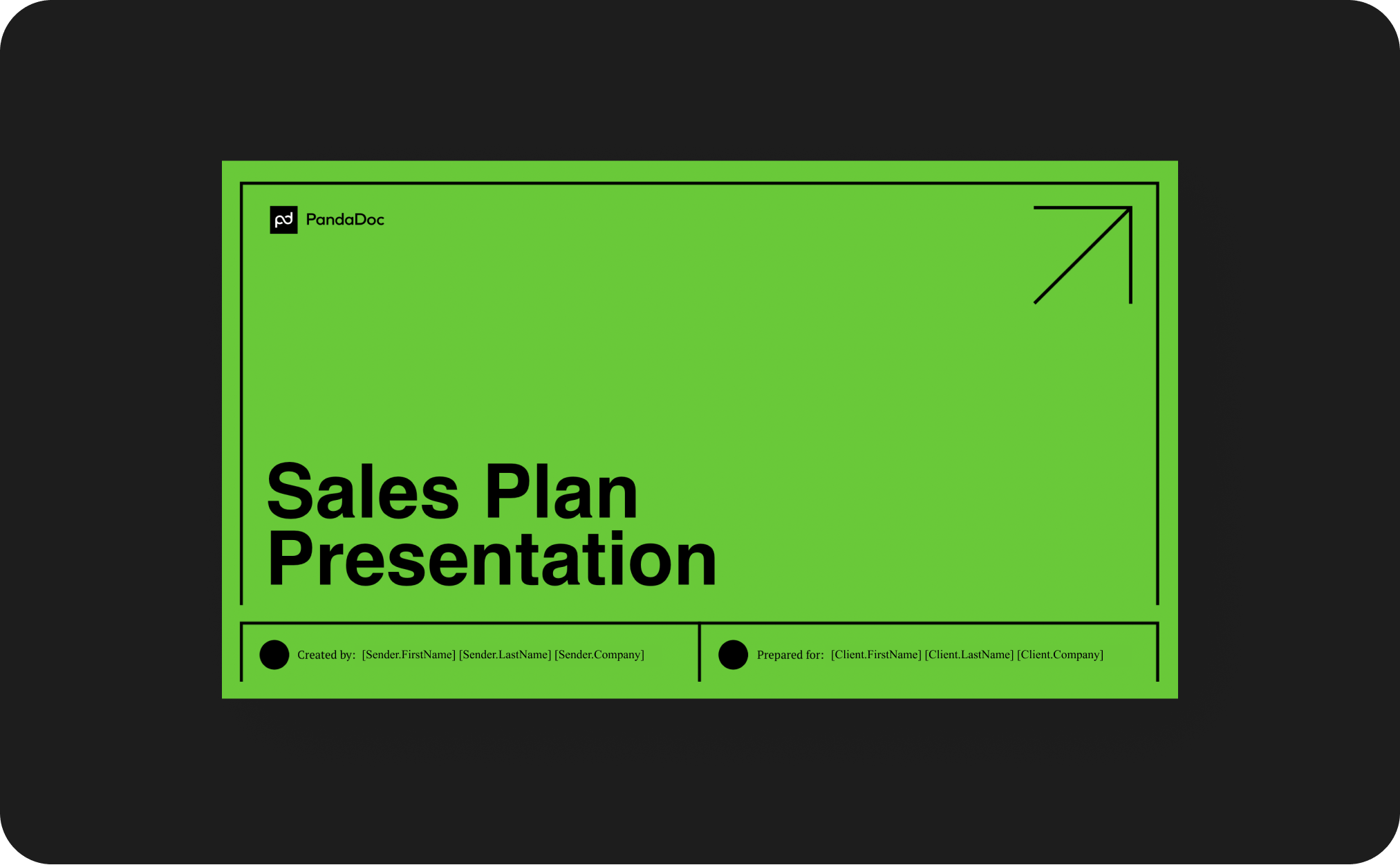
7 Amazing Sales Presentation Examples (And How to Make Them Your Own)

7 Types of Slides to Include In Your Sales Presentation
Inside the mind of your prospect: change is hard, before-after-bridge: the only formula you need to create a persuasive sales presentation, facebook — how smiles and simplicity make you more memorable, contently — how to build a strong bridge, brick by brick, yesware — how to go above and beyond with your benefits, uber — how to cater your content for readers quick to scan, dealtap — how to use leading questions to your advantage, zuora — how to win over your prospects by feeding them dots, linkedin sales navigator — how to create excitement with color, how to make a sales pitch in 4 straightforward steps, 7 embarrassing pitfalls to avoid in your presentation, over to you.
A brilliant sales presentation has a number of things going for it.
Being product-centered isn’t one of them. Or simply focusing on your sales pitch won’t do the trick.
So what can you do to make your offer compelling?
From different types of slides to persuasive techniques and visuals, we’ve got you covered.
Below, we look at data-backed strategies, examples, and easy steps to build your own sales presentations in minutes.
- Title slide: Company name, topic, tagline
- The “Before” picture: No more than three slides with relevant statistics and graphics.
- The “After” picture: How life looks with your product. Use happy faces.
- Company introduction: Who you are and what you do (as it applies to them).
- The “Bridge” slide: Short outcome statements with icons in circles.
- Social proof slides: Customer logos with the mission statement on one slide. Pull quote on another.
- “We’re here for you” slide: Include a call-to-action and contact information.
Many sales presentations fall flat because they ignore this universal psychological bias: People overvalue the benefits of what they have over what they’re missing.
Harvard Business School professor John T. Gourville calls this the “ 9x Effect .” Left unchecked, it can be disastrous for your business.

According to Gourville, “It’s not enough for a new product simply to be better. Unless the gains far outweigh the losses, customers will not adopt it.”
The good news: You can influence how prospects perceive these gains and losses. One of the best ways to prove value is to contrast life before and after your product.
Luckily, there’s a three-step formula for that.
- Before → Here’s your world…
- After → Imagine what it would be like if…
- Bridge → Here’s how to get there.
Start with a vivid description of the pain, present an enviable world where that problem doesn’t exist, then explain how to get there using your tool.
It’s super simple, and it works for cold emails , drip campaigns , and sales discovery decks. Basically anywhere you need to get people excited about what you have to say.
In fact, a lot of companies are already using this formula to great success. The methods used in the sales presentation examples below will help you do the same.
We’re all drawn to happiness. A study at Harvard tells us that emotion is contagious .
You’ll notice that the “Before” (pre-Digital Age) pictures in Facebook’s slides all display neutral faces. But the cover slide that introduces Facebook and the “After” slides have smiling faces on them.
This is important. The placement of those graphics is an intentional persuasion technique.
Studies by psychologists show that we register smiles faster than any other expression. All it takes is 500 milliseconds (1/20th of a second). And when participants in a study were asked to recall expressions, they consistently remembered happy faces over neutral ones.
What to do about it : Add a happy stock photo to your intro and “After” slides, and keep people in “Before” slides to neutral expressions.
Here are some further techniques used during the sales presentation:
Tactic #1: Use Simple Graphics
Use simple graphics to convey meaning without text.
Example: Slide 2 is a picture of a consumer’s hand holding an iPhone — something we can all relate to.
Why It Works: Pictures are more effective than words — it’s called Picture Superiority . In presentations, pictures help you create connections with your audience. Instead of spoon-feeding them everything word for word, you let them interpret. This builds trust.
Tactic #2: Use Icons
Use icons to show statistics you’re comparing instead of listing them out.
Example: Slide 18 uses people icons to emphasize how small 38 out of 100 people is compared to 89 out of 100.
Why It Works: We process visuals 60,000 times faster than text.
Tactic #3: Include Statistics
Include statistics that tie real success to the benefits you mention.
Example: “71% lift driving visits to retailer title pages” (Slide 26).
Why It Works: Precise details prove that you are telling the truth.
Just like how you can’t drive from Marin County to San Francisco without the Golden Gate, you can’t connect a “Before” to an “After” without a bridge.
Add the mission statement of your company — something Contently does from Slide 1 of their deck. Having a logo-filled Customers slide isn’t unusual for sales presentations, but Contently goes one step further by showing you exactly what they do for these companies.

They then drive home the Before-After-Bridge Formula further with case studies:

Before : Customer’s needs when they came on
After: What your company accomplished for them
Bridge : How they got there (specific actions and outcomes)
Here are some other tactics we pulled from the sales presentation:
Tactic #1: Use Graphics/Diagrams
Use graphics, Venn diagrams, and/or equations to drive home your “Before” picture.
Why It Works: According to a Cornell study , graphs and equations have persuasive power. They “signal a scientific basis for claims, which grants them greater credibility.”
Tactic #2: Keep Slides That Have Bullets to a Minimum
Keep slides that have bullets to a minimum. No more than one in every five slides.
Why It Works: According to an experiment by the International Journal of Business Communication , “Subjects exposed to a graphic representation paid significantly more attention to , agreed more with, and better recalled the strategy than did subjects who saw a (textually identical) bulleted list.”
Tactic #3: Use Visual Examples
Follow up your descriptions with visual examples.
Example: After stating “15000+ vetted, ready to work journalists searchable by location, topical experience, and social media influence” on Slide 8, Contently shows what this looks like firsthand on slides 9 and 10.
Why It Works: The same reason why prospects clamor for demos and car buyers ask for test drives. You’re never truly convinced until you see something for yourself.
Which is more effective for you?
This statement — “On average, Yesware customers save ten hours per week” — or this image:

The graphic shows you what that 10 hours looks like for prospects vs. customers. It also calls out a pain that the product removes: data entry.
Visuals are more effective every time. They fuel retention of a presentation from 10% to 65% .
But it’s not as easy as just including a graphic. You need to keep the design clean.

Can you feel it?
Clutter provokes anxiety and stress because it bombards our minds with excessive visual stimuli, causing our senses to work overtime on stimuli that aren’t important.
Here’s a tip from Yesware’s Graphic Designer, Ginelle DeAntonis:
“Customer logos won’t all necessarily have the same dimensions, but keep them the same size visually so that they all have the same importance. You should also disperse colors throughout, so that you don’t for example end up with a bunch of blue logos next to each other. Organize them in a way that’s easy for the eye, because in the end it’s a lot of information at once.”
Here are more tactics to inspire sales presentation ideas:
Tactic #1: Personalize Your Final Slide
Personalize your final slide with your contact information and a headline that drives emotion.
Example: Our Mid-Market Team Lead Kyle includes his phone number and email address with “We’re Here For You”
Why It Works: These small details show your audience that:
- This is about giving them the end picture, not making a sale
- The end of the presentation doesn’t mean the end of the conversation
- Questions are welcomed
Tactic #2: Pair Outcome Statements With Icons in Circles
Example: Slide 4 does this with seven different “After” outcomes.
Why It Works: We already know why pictures work, but circles have power , too. They imply completeness, infiniteness, and harmony.
Tactic #3: Include Specific Success Metrics
Don’t just list who you work with; include specific success metrics that hit home what you’ve done for them.
Example: 35% New Business Growth for Boomtrain; 30% Higher Reply Rates for Dyn.
Why It Works: Social proof drives action. It’s why we wait in lines at restaurants and put ourselves on waitlists for sold-out items.
People can only focus for eight seconds at a time. (Sadly, goldfish have one second on us.)
This means you need to cut to the chase fast.
Uber’s headlines in Slides 2-9 tailor the “After” picture to specific pain points. As a result, there’s no need to explicitly state a “Before.”

Slides 11-13 then continue touching on “Before” problems tangentially with customer quotes:

So instead of self-touting benefits, the brand steps aside to let consumers hear from their peers — something that sways 92% of consumers .
Leading questions may be banned from the courtroom, but they aren’t in the boardroom.
DealTap’s slides ask viewers to choose between two scenarios over and over. Each has an obvious winner:

Ever heard of the Focusing Effect?
It’s part of what makes us tick as humans and what makes this design move effective. We focus on one thing and then ignore the rest. Here, DealTap puts the magnifying glass on paperwork vs. automated transactions.
Easy choice.
Sure, DealTap’s platform might have complexities that rival paperwork, but we don’t think about that. We’re looking at the pile of work one the left and the simpler, single interface on the right.
Here are some other tactics to use in your own sales presentation:
Tactic #1: Tell a Story
Tell a story that flows from one slide to the next.
Example: Here’s the story DealTap tells from slides 4 to 8: “Transactions are complicated” → “Expectations on all sides” → “Too many disconnected tools” → “Slow and error prone process” → “However, there’s an opportunity.
Why It Works: Storytelling in sales with a clear beginning and end (or in this case, a “Before” and “After”) trigger a trust hormone called Oxytocin.
Tactic #2: This vs. That
If it’s hard to separate out one “Before” and “After” vision with your product or service because you offer many dissimilar benefits, consider a “This vs. That” theme for each.
Why It Works: It breaks up your points into simple decisions and sets you up to win emotional reactions from your audience with stock photos.
Remember how satisfying it was to play connect the dots? Forming a bigger picture out of disconnected circles.
That’s what you need to make your audience do.

Zuora tells a story by:
- Laying out the reality (the “Before” part of the Before-After-Bridge formula).
- Asking you a question that you want to answer (the “After”)
- Giving you hints to help you connect the dots
- Showing you the common thread (the “Bridge”)
You can achieve this by founding your sales presentation on your audience’s intuitions. Set them up with the closely-set “dots,” then let them make the connection.
Here are more tactical sales presentation ideas to steal for your own use:
Tactic #1: Use Logos and Testimonials
Use logos and testimonial pull-quotes for your highest-profile customers to strengthen your sales presentation.
Example: Slides 21 to 23 include customer quotes from Schneider Electric, Financial Times, and Box.
Why It Works: It’s called social proof . Prospects value other people’s opinions and trust reputable sources more than you.
Tactic #2: Include White Space
Pad your images with white space.
Example: Slide 17 includes two simple graphics on a white background to drive home an important concept.
Why It Works: White space creates separation, balance, and attracts the audience’s eyes to the main focus: your image.
Tactic #3: Incorporate Hard Data
Incorporate hard data with a memorable background to make your data stand out.
Example: Slide 5 includes statistics with a backdrop that stands out. The number and exciting title (‘A Global Phenomenon’) are the main focuses of the slide.
Why It Works: Vivid backdrops are proven to be memorable and help your audience take away important numbers or data.
Psychology tells us that seeing colors can set our mood .
The color red is proven to increase the pulse and heart rate. Beyond that, it’s associated with being active, aggressive, and outspoken. LinkedIn Sales Navigator uses red on slides to draw attention to main points:

You can use hues in your own slides to guide your audience’s emotions. Green gives peace; grey adds a sense of calm; blue breeds trust. See more here .
Tip: You can grab free photos from Creative Commons and then set them to black & white and add a colored filter on top using a (also free) tool like Canva . Here’s the sizing for your image:

Caveat: Check with your marketing team first to see if you have a specific color palette or brand guidelines to follow.
Here are some other takeaways from LinkedIn’s sales presentation:
Tactic #1: Include a CTA on Final Slide
Include one clear call-to-action on your final slide.
Example: Slide 9 has a “Learn More” CTA button.
Why It Works: According to the Paradox of Choice , the more options you give, the less likely they are to act.
Step One : Ask marketing for your company’s style guide (color, logo, and font style).
Step Two: Answer these questions to outline the “Before → After → Bridge” formula for your sales pitch :
- What are your ICP’s pain points?
- What end picture resonates with them?
- How does your company come into play?
Step Three: Ask account management/marketing which customers you can mention in your slides (plus where to access any case studies for pull quotes).
Step Four: Download photos from Creative Commons . Remember: Graphics > Text. Use Canva to edit on your own — free and fast.

What are the sales presentation strategies that work best for your industry and customers? Tweet us: @Yesware .
Get sales tips and strategies delivered straight to your inbox.
Yesware will help you generate more sales right from your inbox. Try our Outlook add-on or Gmail Chrome extension for free, forever!
Hit your number every month
Works on Outlook or Gmail (+ many more integrations)
Related Articles
![presentation for sales plan 10 Best Persuasive Techniques for Sales and Marketing [2022]](https://www.yesware.com/blog/_next/image/?url=https%3A%2F%2Fwww.yesware.com%2Fwp-content%2Fuploads%2F2021%2F07%2Fyesware-persuasive-techniques.jpg&w=1280&q=75)
10 Best Persuasive Techniques for Sales and Marketing [2022]
Melissa Williams

SPIN Selling: All-In-One Guide for 2022

High-Ticket Sales: How to Sell High-Ticket Products and Services
Casey O'Connor
Sales, deal management, and communication tips for your inbox
We're on a mission to help you build lasting business relationships.
75 Kneeland Street, Floor 15 Boston, MA 02111

IMAGES
VIDEO
COMMENTS
Gain support for your sales plan by thoughtfully crafting presentation materials. Get some tips, examples, and presentation templates.
Sticking to these five simple sales presentation guidelines, recommended by Marc Wayshak, will help you blow your competition away while dramatically increasing your chances of closing the sale. 1. Lead with solutions.
Sales plans outline your goals, strategies, competitors, and more. Use our template and tips to write a sales plan that increases revenue at your company.
A sales presentation is a live meeting where your team showcases your product or service and why it’s the best option for your prospect. Although the terminology differs from company to company, a sales presentation is not always the same as a sales pitch.
Use this free business proposal presentation template to create a strong deck that impresses your potential clients. Download our sales plan presentation template to easily share sales targets and tactics with your company leadership and team.
7 top-notch sales presentation examples from companies like Facebook, Uber, and LinkedIn (and how to adapt their strategies for your own use).